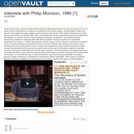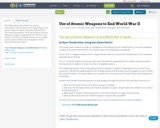
At age twenty-seven, physicist Philip Morrison joined the Manhattan Project, the code name given to the U.S. government's covert effort at Los Alamos to develop the first nuclear weapon. The Manhattan Project was also the most expensive single program ever financed by public funds. In this video segment, Morrison describes the charismatic leadership of his mentor, J. Robert Oppenheimer, and the urgency of their mission to manufacture a weapon 'which if we didn't make first would lead to the loss of the war." In the interview Morrison conducted for War and Peace in the Nuclear Age: 'Dawn,' he describes the remote, inaccessible setting of the laboratory that operated in extreme secrecy. It was this physical isolation, he maintains, that allowed scientists extraordinary freedom to exchange ideas with fellow physicists. Morrison also reflects on his wartime fears. Germany had many of the greatest minds in physics and engineering, which created tremendous anxiety among Allied scientists that it would win the atomic race and the war, and Morrison recalls the elaborate schemes he devised to determine that country's atomic progress. At the time that he was helping assemble the world's first atomic bomb, Morrison believed that nuclear weapons 'could be made part of the construction of the peace.' A month after the war, he toured Hiroshima, and for several years thereafter he testified, became a public spokesman, and lobbied for international nuclear cooperation. After leaving Los Alamos, Morrison returned to academia. For the rest of his life he was a forceful voice against nuclear weapons.
- Subject:
- Arts and Humanities
- Economics
- History
- Political Science
- Social Science
- U.S. History
- Material Type:
- Diagram/Illustration
- Primary Source
- Provider:
- PBS LearningMedia
- Provider Set:
- WGBH Open Vault
- Date Added:
- 02/26/1986
